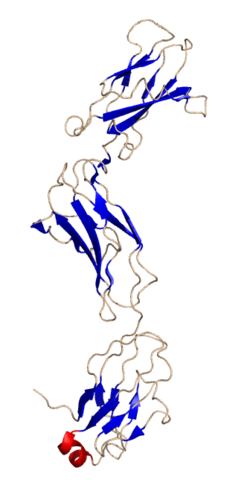Characteristics
The members of the IL-6 receptor family are all complex with gp130 for signal transduction. For example, IL-6 binds to the IL-6 Receptor. The complex of these two proteins then associates with gp130. This complex of 3 proteins then homodimerizes to form a hexameric complex which can produce downstream signals. [7] There are many other proteins which associate with gp130, such as cardiotrophin 1 (CT-1), leukemia inhibitory factor (LIF), ciliary neurotrophic factor (CNTF), oncostatin M (OSM), and IL-11. [8] There are also several other proteins which have structural similarity to gp130 and contain the WSXWS motif and preserved cysteine residues. Members of this group include LIF-R, OSM-R, and G-CSF-R.
Inhibition of gp130
gp130 is an important part of many different types of signaling complexes. Inactivation of gp130 during development is lethal to mice. [9] Homozygous mice who are born show a number of defects including impaired development of the ventricular myocardium. Haematopoietic effects included reduced numbers of stem cells in the spleen and liver. Loss of gp130 in the adult mouse, either globally or in a tissue-specific manner, is however increasingly linked with beneficial effects in a number of mouse models of disease. [10] Of note, soluble gp130 (sgp130), which was thought a specific inhibitor of IL6 trans signalling, was instead found to inhibit not only IL6 signalling but also multiple other IL6-family cytokines (e.g. OSM, IL11 and CNTF). [10] Thus the widespread benefits of sgp130 in mouse models, [11] and in human trials, [12] may represent the benefits of global (or near global) inhibition of gp130. This suggests gp130 itself as a therapeutic target for human diseases including sepsis, systemic sclerosis, inflammatory bowel disease, among others.
This page is based on this
Wikipedia article Text is available under the
CC BY-SA 4.0 license; additional terms may apply.
Images, videos and audio are available under their respective licenses.









